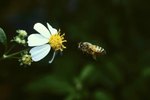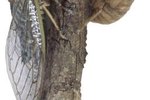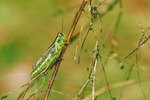
Scavenger insects are essential to the ecosystems in which they exist, as they clear away rotting flesh and vegetation. Scavengers are typically omnivorous, feeding opportunistically. Many animal orders include scavengers; from the largest big cats to the smallest insects. Many insect scavengers are considered pests and rely on humans to provide food for them to scavenge, but scavengers are also beneficial to other animals.
Evolving Scavenger Insects
Members of the scavenger beetle family (Hydrophilidae) are versatile feeders and are not solely scavengers, despite their name. These aquatic beetles feed mainly on decaying organic matter, but some have adapted to become part-time predators too. These tiny beetles are not considered pests and are of benefit to human settlements. Although it is not named for its scavenging habits per se, the dung beetle is perhaps the best known scavenging beetle. It feeds on the excrement of other animals and is famous for rolling dung into balls for later consumption. However, one species of dung beetle has evolved into quite a ferocious predator. The D. valgum variety of dung beetle has been observed attacking, killing and eating millipedes up to 10 times its own length.
Helpful Scavenger Insects
Matter doesn’t need to be dead to attract scavengers; decaying or rotting is good enough. The blowfly (Calliphoridae) family of flies are quite happy to feed on the decaying flesh in the wounds of cattle and sheep. As unpleasant as this sounds, the blowfly’s taste for rotting flesh is beneficial to the animal upon whom he is feeding. Only the rotting flesh is eaten, preventing infection from spreading and keeping the animal relatively healthy.
Efficient Scavenger Insects
Australia’s desert ants (Cataglyphis) wait until first light before searching for a meal to scavenge. They butcher dead insects into manageable chunks, then carry them underground for feeding. In doing this, they not only provide their own nutrition, they also provide nutrition for the mulga trees that grow in the desert.
Party Pooping Scavenger Insects
Yellowjackets and wasps (both of the genera Vespula) are versatile feeders. Most typically feed on plants, although if food is scarce, they will turn to scavenging to feed themselves. Those that have had a picnic or al fresco meal ruined by a swarm of hungry wasps will be only too familiar with the scavenging habits of these brightly colored stinging insects.
Pest Scavengers
Cockroaches (Blattodea) are arguably the least fussy eaters of all insects, capable of drawing nutrients from paper, clothing, dead plants and animals. These pests are superbly adapted to scavenging, as they are able to survive in almost any environment in which scavenging opportunities present themselves. Not all roaches are pests, but those that come into contact with humans are typically regarded as unwelcome, as they spread disease.
References
- Texas A&M University; Department of Entomology: Water Scavenger Beetle
- BBC News: Little Dung Beetle is Big Chopper
- National Geographic: Scavenger
- BBC Nature: Scavenger; Desert Ants
- University of Carolina Agriculture and Natural Resources: Yellowjackets and Other Social Wasps
- Nature Works: Scavengers
Photo Credits
-
Hemera Technologies/PhotoObjects.net/Getty Images
Writer Bio
Simon Foden has been a freelance writer and editor since 1999. He began his writing career after graduating with a Bachelors of Arts degree in music from Salford University. He has contributed to and written for various magazines including "K9 Magazine" and "Pet Friendly Magazine." He has also written for Dogmagazine.net.




